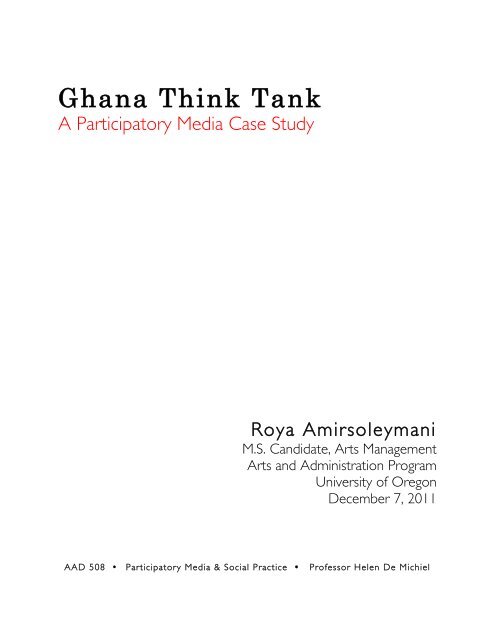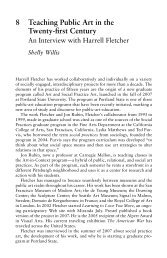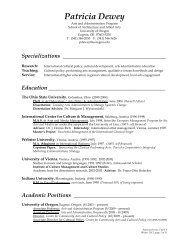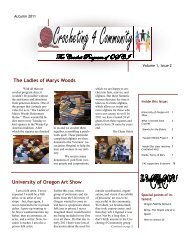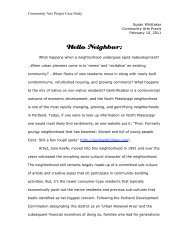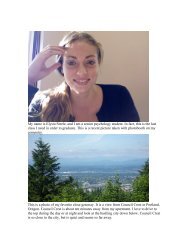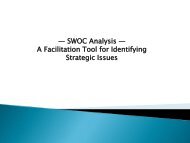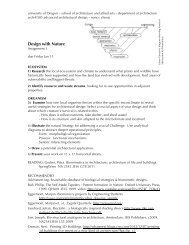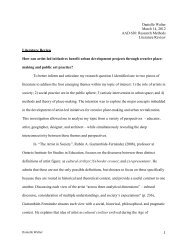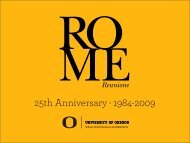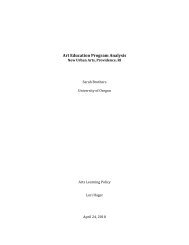Ghana Think Tank - School of Architecture and Allied Arts Blog ...
Ghana Think Tank - School of Architecture and Allied Arts Blog ...
Ghana Think Tank - School of Architecture and Allied Arts Blog ...
Create successful ePaper yourself
Turn your PDF publications into a flip-book with our unique Google optimized e-Paper software.
<strong>Ghana</strong> <strong>Think</strong> <strong>Tank</strong><br />
A Participatory Media Case Study<br />
Roya Amirsoleymani<br />
M.S. C<strong>and</strong>idate, <strong>Arts</strong> Management<br />
<strong>Arts</strong> <strong>and</strong> Administration Program<br />
University <strong>of</strong> Oregon<br />
December 7, 2011<br />
AAD 508 Participatory Media & Social Practice Pr<strong>of</strong>essor Helen De Michiel
1. <strong>Ghana</strong> <strong>Think</strong> <strong>Tank</strong>: Dissolving Dichotomies<br />
On a number <strong>of</strong> levels, <strong>Ghana</strong> <strong>Think</strong> <strong>Tank</strong> strives to dissolve dichotomies, or disrupt those<br />
notions <strong>of</strong> difference that perpetuate cultural misunderst<strong>and</strong>ings <strong>and</strong> reinforce hegemonic<br />
power structures. By using self-organized citizen think tanks in “developing” nations to<br />
propose solutions to problems in “developed” ones, the project helps develop connections<br />
between cultural, social, political, <strong>and</strong> geographical groups that are <strong>of</strong>ten presented as<br />
inherently different or without points <strong>of</strong> convergence or intersection, presenting<br />
opportunities for intercultural connection <strong>and</strong> community interaction across false binary<br />
oppositions like East/West, first world/third world, religious/non-religious,<br />
democracy/theocracy, <strong>and</strong> old/young. In the context <strong>of</strong> participatory media, <strong>Ghana</strong> <strong>Think</strong><br />
<strong>Tank</strong> also breaks down a very particular assumed dichotomy: that <strong>of</strong> real/virtual worlds.<br />
A number <strong>of</strong> theories purport that the notion <strong>of</strong> any substantive difference between “real”<br />
<strong>and</strong> “virtual” worlds today is outdated, as the “tangible” elements <strong>of</strong> individual, communal,<br />
<strong>and</strong> social lived experiences <strong>of</strong>fline are inextricably intertwined with online <strong>and</strong> digital<br />
media, tools, <strong>and</strong> platforms. According to Lister, et. al (2009), “[i]n networked,<br />
technologically intensive societies we increasingly pass between actual <strong>and</strong> virtual realities”<br />
(2009, p. 37). In turn, these authors emphasize that simulations <strong>and</strong> simulated<br />
environments “are real, they exist, <strong>and</strong> are experienced within the real world which they<br />
augment” [emphasis is mine] (2009, p. 44).<br />
Charlie Gere (2008) argues for the value <strong>of</strong> our use <strong>of</strong> digital tools <strong>and</strong> culture to resist<br />
power <strong>and</strong> make social change, <strong>and</strong> <strong>Ghana</strong> <strong>Think</strong> <strong>Tank</strong> aims for social change <strong>and</strong> impact<br />
through innovative models for intercultural dialogue <strong>and</strong> community engagement.<br />
I would add that the value <strong>of</strong> digital tools Gere puts forth can be maximized through hybrid<br />
approaches to resistance activity, <strong>and</strong> <strong>Ghana</strong> <strong>Think</strong> <strong>Tank</strong> is an exemplary project in the<br />
realm <strong>of</strong> hybrid online/<strong>of</strong>fline programming <strong>and</strong> documentation that helps us move forward<br />
in theorizing notions <strong>and</strong> testing hypotheses <strong>of</strong> participatory media that ab<strong>and</strong>on the<br />
irrelevant real/virtual dichotomy. Lister, et. al. help frame the notion <strong>of</strong> combined<br />
<strong>of</strong>fline/online, or place-based/digital, or even (formerly) real/virtual participatory media<br />
designs <strong>and</strong> platforms <strong>and</strong> their value to digital resistance in new media.<br />
Thus, both the formerly “real” <strong>and</strong> formerly “virtual” are both real, <strong>and</strong> a hybridized<br />
approach to socially engaged art <strong>and</strong> resistance activity is critical if such projects aim to<br />
reach broad <strong>and</strong> diverse audiences, create conditions for active <strong>and</strong> rich public participation<br />
<strong>and</strong> dialogue, engender transformative experiences for participants, move communities<br />
toward positive social change initiatives <strong>and</strong> innovative problem-solving techniques, open<br />
up space for dialogue <strong>and</strong> intellectual <strong>and</strong> political exchange, <strong>and</strong> experiment with new<br />
approaches to living.<br />
As such, <strong>Ghana</strong> <strong>Think</strong> <strong>Tank</strong> is informed by Gere’s theory <strong>of</strong> the resistance capabilities <strong>of</strong><br />
digital culture <strong>and</strong> media well as that <strong>of</strong> Lister, et. al, who argue that the notion <strong>of</strong> a<br />
real/virtual binary is a false dichotomy; <strong>Ghana</strong> <strong>Think</strong> <strong>Tank</strong> collectively embodies <strong>and</strong><br />
practices these theories in such a way as to test the hypothesis that such resistance <strong>and</strong><br />
cultural activity—especially in the context <strong>of</strong> relational/participatory/socially engaged art<br />
<strong>and</strong> social practice—is most effective when both place-based <strong>and</strong> online components are<br />
incorporated, dissolving the distinction between real/virtual (or rather, helping to define a<br />
2
new norm that fully integrates both) that is in line with emerging research, theory, <strong>and</strong><br />
practice in both participatory art/media <strong>and</strong> arts participation.<br />
2. History <strong>and</strong> Overview <strong>of</strong> <strong>Ghana</strong> <strong>Think</strong> <strong>Tank</strong><br />
<strong>Ghana</strong> <strong>Think</strong> <strong>Tank</strong> (GTT) was created in 2006 by graduate students at the Rhode Isl<strong>and</strong><br />
<strong>School</strong> <strong>of</strong> Design as an art project now also considered to be an exercise in community <strong>and</strong><br />
cultural exchange. GTT is a “worldwide network <strong>of</strong> think tanks creating strategies to resolve<br />
local problems in the developed world” (2009, ffotogallery). This network includes selforganized<br />
think tanks in <strong>Ghana</strong>, Cuba, El Salvador, Serbia, Mexico, Ethiopia, Iran, <strong>and</strong> in a<br />
program for incarcerated girls in Boston, <strong>and</strong> are comprised <strong>of</strong> average citizens with no<br />
training or background in “international development” (C. Montoya, Personal<br />
communication, December 1, 2011).<br />
<strong>Ghana</strong> <strong>Think</strong> <strong>Tank</strong> exists as a computer- <strong>and</strong> internet-equipped teardrop trailer that visits<br />
first-world communities <strong>and</strong> asks locals to identify “problems” in their neighborhood, town,<br />
community, or city. Those problems are sent to the “third world” think tanks mentioned<br />
above, which collectively propose solutions to these first-world problems. According to the<br />
GTT website, “[s]ome <strong>of</strong> these actions have produced workable solutions, but others have<br />
created intensely awkward situations, as we play out different cultures' assumptions about<br />
each other.” (<strong>Ghana</strong> <strong>Think</strong> <strong>Tank</strong>, 2011)<br />
The final step <strong>of</strong> this exchange is for the “host” communities that initially posed the problem<br />
to enact one or more <strong>of</strong> the solutions proposed by the think tanks, thus experimenting with<br />
new methods for solving unusual problems. The results <strong>of</strong> many <strong>of</strong> these exchanges <strong>and</strong><br />
actions are documented, publicly presented, <strong>and</strong> formally exhibited in partnership with art<br />
spaces, museums, universities, nonpr<strong>of</strong>its, social service groups, <strong>and</strong> other commissioning<br />
or sponsoring institutions in the host communities, thus manifesting as both a social<br />
change-oriented <strong>and</strong> community-driven initiative <strong>and</strong> a contemporary art project, all the<br />
while serving multiple participant groups through positive, challenging, engaged<br />
interaction, including think tank members, host community members, audiences, exhibition<br />
viewers, <strong>and</strong> website visitors. Further detail on the step-by-process followed for each GTT<br />
project is provided below.<br />
3. Project Purpose: Intercultural Exchange through Experimental Problem Solving<br />
[<strong>Ghana</strong> <strong>Think</strong> <strong>Tank</strong>] has become a way to explore the friction caused by solutions that are<br />
generated in one context <strong>and</strong> applied elsewhere, while revealing the hidden assumptions<br />
that govern cross-cultural interactions.<br />
– <strong>Ghana</strong> <strong>Think</strong> <strong>Tank</strong> website, 2011<br />
<strong>Ghana</strong> <strong>Think</strong> <strong>Tank</strong> is a response to the problematic practice <strong>and</strong> power dynamics <strong>of</strong><br />
developed or first world nations “saving” or solving the problems <strong>of</strong> developing or third<br />
world nations through organized initiatives. According to an interview with GTT<br />
(Tikhonova, 2011), “[a]t the heart <strong>of</strong> this project is socially mediated problem solving, an<br />
activity which bridges divergent cultures <strong>and</strong> technologies. The intention is to transpose<br />
parts <strong>of</strong> one culture into another.”<br />
3
As discussed, in order to do this, the project partners with self-organized think tanks in the<br />
developing countries described above that generate “characteristically playful social<br />
interventions” in response to problems posed by communities in the developed/first world.<br />
According to <strong>Ghana</strong> <strong>Think</strong> <strong>Tank</strong>, “the ambition is to challenge the hidden assumptions that<br />
govern many cross-cultural interactions. Traditional power-roles are swapped, places are<br />
exchanged <strong>and</strong> communities are connected through what had previously been their<br />
differences.” (artspolicynow.org, 2011)<br />
The think tank process is three-fold, incorporating problems, solutions, <strong>and</strong> actions. It<br />
begins with GTT’s trailer being used in an actual community in the developed world (e.g.,<br />
German towns; New York City neighborhoods) to collect proposed problems. Host<br />
communities generally have some form <strong>of</strong> commissioning funding for GTT <strong>and</strong> work with<br />
project leaders to develop the procedural aspects <strong>of</strong> the partnership <strong>and</strong> the logistics <strong>of</strong><br />
bringing GTT to its physical site. The problems posed by host communities might include<br />
those that seem curious, humorous, or even inconsequential, such as a town being “too flat<br />
<strong>and</strong> boring” (Karlsruhe, Germany) or that “PowerPoint is ruining our minds”<br />
(MobilityShifts Conference, The New <strong>School</strong>, New York); more broadly social, such as old<br />
people being viewed as a burden to society (Wales) or the lack <strong>of</strong> sensory learning in the<br />
digital age (MobilityShifts Conference, The New <strong>School</strong>, New York); to highly specific <strong>and</strong><br />
divisive issues informed by ethnic, racial, <strong>and</strong> gender-based history, tension, violence, or<br />
social injustice, such as a lack <strong>of</strong> connection <strong>and</strong> communication between Serbs <strong>and</strong><br />
Albanians across the river in the town <strong>of</strong> Mitrovica (Serbia/Albania) or high levels <strong>of</strong> police<br />
harassment (Corona, Queens, New York City).<br />
Once problems are posed by locals in host communities, they are shared electronically with<br />
the self-organized think tanks explained above in any number <strong>of</strong> the developing countries<br />
who participate in GTT; the think tanks then generate <strong>and</strong> respond to the communities with<br />
proposed solutions taken from their own cultural <strong>and</strong> human contexts, thus contributing to<br />
a developing inter- <strong>and</strong> cross-cultural exchange between groups in two countries that<br />
probably know very little about one another, especially when it comes to the general public<br />
who comprise participants on both ends.<br />
One <strong>of</strong> GTT’s core artists/group leaders, Carmen Montoya, describes the organization <strong>of</strong><br />
think tanks <strong>and</strong> how they fit into the overall project scheme:<br />
The think tanks grow out <strong>of</strong> personal connections with people in other countries or who work in<br />
domestic organizations…sometimes a think tank is a pre-existing group, as with Artistic Noise,<br />
who make up the Incarcerated Girls think tank in Boston. In El Salvador, the think tank is<br />
composed <strong>of</strong> people who run a community radio station. We are currently developing think tanks<br />
in the migrant worker community in Oregon through PCUN <strong>and</strong> in the Oregon prison system. We<br />
keep in contact with the think tanks via email, sending problems, receiving solutions <strong>and</strong> providing<br />
documentation <strong>and</strong> feedback about the implementation <strong>of</strong> solutions. (Personal Communication,<br />
December 1, 2011)<br />
The third step, action, involves the initial host community implementing or enacting one or<br />
more <strong>of</strong> the think tanks’ proposed solutions, whether they seem to make sense or not. This<br />
is an exercise in experimentation that privileges the process <strong>of</strong> community engagement,<br />
dialogue, <strong>and</strong> exchange over end results. However, the larger public in a given host<br />
community has a chance to participate in actions either directly or through exhibitions in<br />
4
museums, art spaces, or other public settings that display the results <strong>of</strong> this three-step<br />
problem-solution-action process <strong>and</strong> its documentation.<br />
One example <strong>of</strong> this process is in Wales, where GTT settled on addressing the problem that<br />
“there seems to be a perception that old people are a burden to society”. The GTT think tank<br />
in Iran then proposed the solution that that communities collect “dirty” stories from their<br />
local old folks (that is, ask them about their sex lives). Communities in Wales took action on<br />
this by partnering with senior citizen centers to produce oral history projects that included<br />
recorded interviews with residents/visitors about their memories <strong>of</strong> first kisses, sex, love,<br />
<strong>and</strong> romance—which proved quite entertaining for the community! The final project was<br />
exhibited as a project <strong>of</strong> <strong>Ghana</strong> <strong>Think</strong> <strong>Tank</strong> at the National Museum <strong>of</strong> Wales.<br />
<strong>Ghana</strong> <strong>Think</strong> <strong>Tank</strong> has a ten-year project plan. Group leaders will assess GTT in 2016 to<br />
determine how to proceed <strong>and</strong> take stock <strong>of</strong> shape, form, <strong>and</strong> direction at that point. After<br />
those ten years, as co-founder Chris Robbins stated in an interview, “we'll see if it has grown<br />
into something else entirely...” (Personal communication, December 1, 2011).<br />
3. Project Leaders<br />
Rhode Isl<strong>and</strong> <strong>School</strong> <strong>of</strong> Design (RISD) graduate students <strong>and</strong> friends Chris Robbins, John<br />
Ewing, <strong>and</strong> Matey Odonkor founded <strong>Ghana</strong> <strong>Think</strong> <strong>Tank</strong> in 2006 as a ten-year project. After<br />
Odonkor left the group, visual artist Maria del Carmen Montoya, who also attended RISD,<br />
joined as the other project leader. Thus, artists became involved in the project through their<br />
shared education, intellectual exchange, <strong>and</strong> artistic collaboration <strong>and</strong> agreed to collectively<br />
develop, fund, maintain, <strong>and</strong> program the project.<br />
Maria del Carmen Montoya is a new media artist who works in sculpture, performance,<br />
<strong>and</strong> video. Her work explores the personal, emotional, <strong>and</strong> utterly irrational tendencies <strong>of</strong><br />
technology. Her collaborative projects include WineBloodBloodLove, a performance <strong>and</strong><br />
sound installation inside the Herman Nitsch retrospective at the Station Museum in<br />
Houston, <strong>and</strong> the creation <strong>of</strong> The Digital Poplar Consort, a family <strong>of</strong> h<strong>and</strong>crafted wireless<br />
musical instruments used in a concert. Her most recent work I Sky You, winner <strong>of</strong> a 2009<br />
Rhizome commission, is an installation that sonifies the radiance <strong>of</strong> chemically synthesized<br />
light. (www.eyebeam.org, retrieved 12/5/11)<br />
Christopher Robbins works on the uneasy cusp <strong>of</strong> public art <strong>and</strong> community action,<br />
creating sculptural interventions in the daily lives <strong>of</strong> strangers. He uses heavy material<br />
dem<strong>and</strong>s <strong>and</strong> a carefully twisted work-process to craft awkwardly intimate social<br />
collaborations.<br />
He built his own hut out <strong>of</strong> mud <strong>and</strong> sticks <strong>and</strong> lived in it while serving as a Peace Corps<br />
Volunteer in Benin, West Africa, spoke at a United Nations conference about his crosscultural<br />
digital arts <strong>and</strong> education work in the South Pacific, <strong>and</strong> has lived <strong>and</strong> worked in<br />
London, Tokyo, West Africa, the Fiji Isl<strong>and</strong>s, <strong>and</strong> former Yugoslavia. He has exhibited at the<br />
New Museum Festival <strong>of</strong> Ideas, Trade <strong>School</strong> at the Whitney Museum, the National<br />
Museum <strong>of</strong> Wales, PERFORMA 07, Nikolaj Kunsthallen/ Copenhagen Contemporary Art<br />
Center, <strong>and</strong> been awarded residencies/ fellowships from Skowhegan, MacDowell Colony,<br />
Haystack, Penl<strong>and</strong>, <strong>and</strong> Anderson Ranch, among others.<br />
5
The <strong>Ghana</strong> <strong>Think</strong> <strong>Tank</strong>, a project he co-founded in 2006, was a finalist for the Frieze<br />
Foundation Cartier Award in 2010 <strong>and</strong> was awarded the Creative Time Open Doors<br />
commission for Public Art at the Queens Museum <strong>of</strong> Art in 2010. (www.christopherrobbins.com;<br />
retrieved 12/5/11)<br />
John Ewing is a digital media artist creating public art with an emphasis on community<br />
participation. He works on large sustained projects that <strong>of</strong>ten last several years. He has<br />
exhibited at the National Museum <strong>of</strong> Wales, FACT, the Foundation for Art <strong>and</strong> Creative<br />
Technology, <strong>and</strong> the Cambridge <strong>Arts</strong> Council, with upcoming shows in New York City <strong>and</strong><br />
Shanghai, China. Previously he worked in El Salvador for two years, using the arts to<br />
organize <strong>and</strong> inspire dialogue about human rights. Other work includes projects in<br />
Nicaragua, Uruguay <strong>and</strong> Cuba, as well as various cities in the U.S. In 2009 he was a<br />
recipient <strong>of</strong> the Knight News Challenge Grant. The <strong>Ghana</strong> <strong>Think</strong> <strong>Tank</strong> has been shortlisted<br />
for the 2010 Cartier Award. (dm.risd.edu; retrieved 12/5/11)<br />
4. Project Partners<br />
Aside from the project leaders mentioned above, the following individuals/groups are<br />
involved with <strong>Ghana</strong> <strong>Think</strong> <strong>Tank</strong> as partner organizations, individual volunteers, or<br />
contracted consultants:<br />
• The Vera List Center for Art at The New <strong>School</strong> (New York City) is dedicated<br />
to serving as a catalyst for the discourse on the role <strong>of</strong> the arts in society <strong>and</strong> their<br />
relationship to the sociopolitical climate in which they are created.<br />
• Kevin Patton, Asst. Pr<strong>of</strong>essor <strong>of</strong> Music <strong>and</strong> Performance Technologies at Oregon<br />
State University, manages GTT’s physical computing<br />
• AJ McGuire is GTT’s webs designer<br />
• Rachel Pedderson, Catherine McTague, <strong>and</strong> Tom Kietz were GTT’s most<br />
recent associates.<br />
• Host communities in the developed world, which put forth the “problems” to be<br />
solved by self-organized, citizen think tanks in developing countries, including<br />
<strong>Ghana</strong>, Cuba, El Salvador, Cambodia, Mexico, the Gaza Strip, Lebanon, Afghanistan,<br />
Iran, Kosovo, Serbia, <strong>and</strong> within Artistic Noise, a program for incarcerated girls in<br />
Boston, Massachusetts.<br />
According to Carmen Montoya (Personal interview, December 1, 2011), “many <strong>of</strong> [GTT’s]<br />
partners grow out <strong>of</strong> relationships in the host community <strong>and</strong> change depending on the<br />
context…for example, in Corona, Queens we worked with the Lion´s Club, Tania Bruguera´s<br />
Immigrant Movement International, <strong>and</strong> Make the Road NY. In Karlsruhe, Germany we<br />
worked with Noah´s Arc Senior Center, Movement Karlsruhe, a parkour [French martial<br />
arts] club, <strong>and</strong> improvisational theatre SERVIERVORSCHLAG.” Thus, Montoya shares here<br />
GTT’s model for temporary partnerships that are site-specific, culturally appropriate, <strong>and</strong><br />
arise as obvious choices for collaboration based on the “problems” posed by community<br />
members as well as their choice <strong>of</strong> “action” or implementation <strong>of</strong> think tanks’ solutions.<br />
Upcoming project partners include the US State Department’s smART Power program, the<br />
Bronx Museum <strong>of</strong> Art, <strong>and</strong> the Arab Image Foundation (<strong>Ghana</strong> <strong>Think</strong> <strong>Tank</strong> website,<br />
retrieved 12/4/11).<br />
6
5. Funding <strong>and</strong> Resources<br />
The following organizations have or continue to support <strong>Ghana</strong> <strong>Think</strong> <strong>Tank</strong> through grants,<br />
donations, <strong>and</strong> commissions. In turn, the group leaders <strong>of</strong>ten front the costs <strong>of</strong> various<br />
incarnations <strong>of</strong> the project until funding is secured through other means. Because GTT is<br />
not a 501(c)(3), it receives fiscal sponsorship through various entities when applying for<br />
grants, or group leaders apply for or seek funding individually or collectively as artists.<br />
Project leader Christopher Robbins has mentioned the group’s interest in the possibility <strong>of</strong><br />
pursuing for-pr<strong>of</strong>it, LLC status (Personal communication, December 1, 2011)<br />
• CEC <strong>Arts</strong>Link promotes international communication <strong>and</strong> underst<strong>and</strong>ing through<br />
collaborative, innovative arts projects for mutual benefit.<br />
• SUNY Purchase College brings two styles <strong>of</strong> education—traditional liberal arts<br />
<strong>and</strong> sciences programs <strong>and</strong> conservatory-based arts programs—into close contact on<br />
one campus, thus striving to inspire an appreciation for both intellectual <strong>and</strong> artistic<br />
talents in all students.<br />
• The Rockefeller Foundation supports work that enables individuals,<br />
communities, <strong>and</strong> institutions to access new tools, practices, resources, services, <strong>and</strong><br />
products.<br />
• Queens Museum <strong>of</strong> Art in New York City presents artistic <strong>and</strong> educational<br />
programs <strong>and</strong> exhibitions that directly relate to the contemporary urban life <strong>of</strong> its<br />
constituents while maintaining the highest st<strong>and</strong>ards <strong>of</strong> pr<strong>of</strong>essional, intellectual,<br />
<strong>and</strong> ethical responsibility.<br />
• Creative Time: Guided by a passionate belief in the power <strong>of</strong> art to create inspiring<br />
personal experiences as well as foster social progress, Creative Time strives to<br />
commission, produce <strong>and</strong> present the most important, ground-breaking, challenging<br />
<strong>and</strong> exceptional art <strong>of</strong> our times—art that infiltrates the public realm <strong>and</strong> engages<br />
millions <strong>of</strong> people in New York City <strong>and</strong> across the globe.<br />
• The Lily Auchincloss Foundation supports art, preservation <strong>and</strong> community<br />
programs that serve to enrich the lives <strong>of</strong> the City.<br />
• Puffin Foundation, Ltd. seeks to open the doors <strong>of</strong> artistic expression by<br />
providing grants to artists <strong>and</strong> art organizations that are <strong>of</strong>ten excluded from<br />
mainstream opportunities due to their race, gender, or social philosophy.<br />
• The Black Rock <strong>Arts</strong> Foundation supports <strong>and</strong> promotes community,<br />
interactive art <strong>and</strong> civic participation.<br />
• The Greenwall Foundation formerly operated an arts <strong>and</strong> humanities program<br />
focused on support for small <strong>and</strong> midsize New York City arts organizations,<br />
especially those fostering experimentation <strong>and</strong> creation <strong>of</strong> new <strong>and</strong> interdisciplinary<br />
work in theater, dance, music, visual <strong>and</strong> literary arts, <strong>and</strong> new media.<br />
• New York City Department <strong>of</strong> Cultural Affairs (DCLA) is dedicated to<br />
supporting <strong>and</strong> strengthening New York City's vibrant cultural life. Among our<br />
primary missions is to ensure adequate public funding for non-pr<strong>of</strong>it cultural<br />
organizations, both large <strong>and</strong> small, throughout the five boroughs.<br />
• New York State Council on the <strong>Arts</strong> is dedicated to preserving <strong>and</strong> exp<strong>and</strong>ing<br />
the rich <strong>and</strong> diverse cultural resources that are <strong>and</strong> will become the heritage <strong>of</strong> New<br />
York's citizens <strong>and</strong> believes in supporting artistic excellence <strong>and</strong> creative freedom <strong>of</strong><br />
artists without censure, the rights <strong>of</strong> all New Yorkers to access <strong>and</strong> experience the<br />
7
power <strong>of</strong> art <strong>and</strong> culture, <strong>and</strong> the vital contribution the arts make to the quality <strong>of</strong> life<br />
in New York communities.<br />
6. Participation Model: Engagement in Both Digital <strong>and</strong> Place-Based Contexts<br />
<strong>Ghana</strong> <strong>Think</strong> <strong>Tank</strong> clearly, comprehensively, <strong>and</strong> purposefully embodies the participatory<br />
qualities <strong>of</strong> community (Week 9). As put forth in our course syllabus, GTT is a transmedia<br />
project “continually grounded in real history, real geography, <strong>and</strong> real time—what we know<br />
as human beings” (Participatory Media <strong>and</strong> Social Practice course blog; retrieved 12/5/11).<br />
This is in part evidenced by GTT’s model <strong>of</strong> engaging real people from divergent cultures<br />
<strong>and</strong> specific communities through self-organized citizen think tanks in developing countries<br />
paired with the project’s connection to actual locals in host communities in developed<br />
countries who put forth the “problems” addressed by the think tanks. By using a physical<br />
trailer that travels throughout the host community seeking input <strong>and</strong> responses on<br />
community problems from locals in public spaces—while providing the privacy <strong>of</strong> the trailer<br />
<strong>and</strong> a personal computer to submit the “problems” in question—GTT welcomes input on<br />
civic, artistic, or even completely irreverent problems, questions, or concerns from<br />
concerned, engaged citizens or those who simply feel welcome to participate in a creative<br />
project thanks to GTT’s open forum <strong>and</strong> method <strong>of</strong> soliciting participation. The trailer could<br />
be parked at a commissioning art space, organization or institution, in a public square, or<br />
outside a government building—somewhere accessible <strong>and</strong> visible to the public. GTT project<br />
<strong>and</strong> partner leaders or volunteers are on h<strong>and</strong> to assist participants if they have questions or<br />
need help submitting a problem via the computer stations or other means.<br />
GTT think tanks demonstrate very particular models for community engagement informed<br />
by culturally specific ways <strong>of</strong> organizing a group <strong>of</strong> people in a developing country to<br />
participate in moving a project through its process. While GTT projects have some<br />
connection to the think tank being formed in a given location, they do not necessarily know<br />
who will end up being in the group, only that the members will not have any experience in<br />
“international development”, which plays into GTT’s subversion <strong>of</strong> the traditional top-down<br />
model <strong>of</strong> global problem-solving.<br />
Thus, these communities form somewhat organically—through a combination <strong>of</strong> in-person<br />
<strong>and</strong> electronic communication forums, or because they are all involved in another<br />
community project together (e.g., a radio station)—<strong>and</strong> manage their time, meetings, <strong>and</strong><br />
ongoing contributions to GTT from their home site, on a volunteer basis, forming a<br />
community that connects with the project leaders as well as the host community to which<br />
they are posing solutions to problems, creating a larger, more complex network <strong>of</strong><br />
intercultural exchange <strong>and</strong> dialogue that transcends the traditional notion <strong>of</strong> real versus<br />
virtual divisions <strong>of</strong> space, place, <strong>and</strong> time. The exception to this organic model <strong>of</strong> think tank<br />
formation/organization is the Artistic Noise program for incarcerated girls in Boston, which<br />
builds the think tank into its programming more formally.<br />
Critical to <strong>Ghana</strong> <strong>Think</strong> <strong>Tank</strong>’s online presence <strong>and</strong> use <strong>of</strong> digital tools <strong>and</strong> media are<br />
documentation <strong>and</strong> archival practices for tracking each cultural exchange arising out <strong>of</strong><br />
GTT. Initial community problems are <strong>of</strong>ten posed electronically through computers in the<br />
GTT trailer. <strong>Think</strong> tanks in developing countries document their decision-making processes<br />
8
through photo <strong>and</strong> video. Both GTT <strong>and</strong> its’ presenting partner organizations document <strong>and</strong><br />
archive projects on their websites through photos, videos, news feeds, <strong>and</strong> blogs <strong>and</strong><br />
through social media outlets, particularly Facebook <strong>and</strong> Twitter.<br />
7. Community-specific Impact: Transformative Participatory Experiences<br />
GTT co-leader Carmen Montoya tells a touching story about the impact <strong>of</strong> <strong>Ghana</strong> <strong>Think</strong><br />
<strong>Tank</strong> that exemplifies the interpersonal connection <strong>and</strong> community collaboration brought<br />
about by successful GTT projects. Here she discusses an incarnation in Germany <strong>of</strong> a<br />
problem originally put forth by someone n Wales: “the elderly are treated like a burden to<br />
society,” to which Iran’s think tank responded, “collect funny dirty stories from old people.”<br />
GTT was in Karlsruhe, Germany for the Global Contemporary Show. I arranged a tea at Noah´s Arc<br />
Senior Center in hopes that I might find someone willing to talk to me there. When I arrived the<br />
administrators ushered me into the back room <strong>of</strong>fice for a briefing. I was told that the center had hosted<br />
artistic projects in the past <strong>and</strong> that they were always very hard for the seniors. I was solemnly reminded<br />
that everyone at the tea that afternoon had lived through World War II, through terrible tragedies, had<br />
suffered hunger, sudden loss <strong>of</strong> family <strong>and</strong> friends, <strong>and</strong> other unspeakable events. Remembering the past<br />
was <strong>of</strong>ten an unpleasant exercise. I explained that I only wanted to socialize with them in a natural way<br />
<strong>and</strong> that there would be none <strong>of</strong> the typical prodding. My plan was to have tea <strong>and</strong> to have fun.<br />
There was a woman there named Carmen who spoke fluent Spanish. She explained that she learned<br />
Spanish from her husb<strong>and</strong>, with whom she had to flee to Holl<strong>and</strong> to marry. In the 1950s it was illegal to<br />
marry a divorcé (her husb<strong>and</strong> was divorced) in Germany, so they ran away together, leaving everything<br />
<strong>and</strong> everyone to marry in Holl<strong>and</strong>. As we drank tea <strong>and</strong> ate cake, a far-away look came over her face <strong>and</strong><br />
she said, "Oh, those were good days." She told me about romps in the bushes on the way out <strong>of</strong> town <strong>and</strong><br />
was simply giddy after our chat. People around us became curious about the unintelligible Spanish <strong>and</strong> all<br />
the giggles, <strong>and</strong> soon people were volunteering <strong>and</strong> jesting about who was naughtier than the other. By<br />
the end <strong>of</strong> tea, we were all one enormous group <strong>of</strong> giggling senior citizens (plus me) vying for the title <strong>of</strong><br />
"most naughty," grabbing at the recorder for a chance to go back to those "lovely days"... to kiss <strong>and</strong> tell. It<br />
was such fun. The uniqueness <strong>of</strong> GTT is that the project is about the community´s agenda. As artists, we<br />
are but catalysts for a dialogue just waiting to happen. (Personal communication, December 1, 2011).<br />
As Montoya says, one <strong>of</strong> the most unique qualities <strong>of</strong> <strong>Ghana</strong> <strong>Think</strong> <strong>Tank</strong> is its ability to<br />
create conditions for community to come together around what it is they need or want, not<br />
to impose solutions or notions <strong>of</strong> what works best elsewhere. The community’s “agenda”<br />
guides the project through both its process <strong>and</strong> its end results, which really don’t end, but<br />
rather reverberate throughout the communities it touches through conversation <strong>and</strong><br />
dialogue, memory, <strong>and</strong> tangible change.<br />
8. Methods <strong>of</strong> Participation<br />
<strong>Ghana</strong> <strong>Think</strong> <strong>Tank</strong>’s process, methods, vision, <strong>and</strong> values demonstrate an awareness <strong>of</strong> <strong>and</strong><br />
emphasis on emerging arts participation theory <strong>and</strong> practice. For example, as previously<br />
described, GTT is committed to presenting projects in both place-based <strong>and</strong> digital contexts,<br />
which allows it to serve the mission <strong>of</strong> many <strong>of</strong> its funders <strong>and</strong> sponsors in making socially<br />
engaged, community-oriented experimental art available <strong>and</strong> accessible to a broad public.<br />
GTT’s combined use <strong>of</strong> electronic, digital, <strong>and</strong> place-based engagement methods<br />
demonstrates their value <strong>of</strong> a variety <strong>of</strong> methods <strong>of</strong> interactivity <strong>and</strong> presentation that serve<br />
a number <strong>of</strong> purposes: participants with lower levels <strong>of</strong> media literacy can still participate in<br />
9
the project; those who seek more online interaction <strong>and</strong> exchange have a plethora <strong>of</strong><br />
resources, information, <strong>and</strong> archival images <strong>and</strong> texts to reference after the projects are<br />
complete; funders can easily track the trajectory <strong>of</strong> a project; multiple partners can share<br />
the project on their own websites; <strong>and</strong> exhibitions <strong>of</strong> projects’ final products can employ<br />
both place-based <strong>and</strong> digital tools for engaging current <strong>and</strong> new audiences, or those who<br />
were already a part <strong>of</strong> the project as well as those br<strong>and</strong> new to it. This demonstrates an<br />
awareness on the part <strong>of</strong> GTT <strong>of</strong> the need for multiple nodes <strong>of</strong> entry for participants <strong>and</strong><br />
the provision <strong>of</strong> multiple levels <strong>and</strong> types <strong>of</strong> interaction <strong>and</strong> engagement options for<br />
audiences, viewers, visitors, <strong>and</strong> participants, which can be tailored in terms <strong>of</strong> cultural<br />
context, site specificity, media literacy, <strong>and</strong> community dynamics. The need for making<br />
diverse levels <strong>and</strong> methods <strong>of</strong> participation available to audiences <strong>and</strong> publics is an<br />
emerging best practice in arts <strong>and</strong> culture programming, supported by recent research from<br />
museum studies scholar Nina Simon in her book The Participatory Museum (2010) <strong>and</strong><br />
The James Irvine Foundation’s report Getting In On the Act: How <strong>Arts</strong> Groups are<br />
Creating Opportunities for Active Participation (2011).<br />
9. Weathering Economic <strong>and</strong> Technical Challenges<br />
Neither Robbins nor Montoya feel that <strong>Ghana</strong> <strong>Think</strong> <strong>Tank</strong> is currently faced with<br />
exceptional economic challenges, though they maintain that the project’s operations are<br />
sustainable <strong>and</strong> lean, using as much recycled material <strong>and</strong> found resources as possible, <strong>and</strong><br />
that they <strong>of</strong>ten rely on the generosity <strong>of</strong> volunteers. Says Montoya, “this is possible in part<br />
because the issues we work with are ones that rise up from the community <strong>and</strong> people have<br />
an interest in resolving.” In turn, GTT’s core artists (Robbins, Montoya, <strong>and</strong> Ewing) have<br />
other means <strong>of</strong> supporting themselves <strong>and</strong> so will <strong>of</strong>ten front the cost <strong>of</strong> an initial project<br />
while awaiting institutional support, or they will work for very small honorarium fees.<br />
“Funding has not been ideal, but we make it work,” says Montoya (Personal communication,<br />
December 1, 2011).<br />
However, Montoya <strong>and</strong> Robbins both agree that there are broader financial challenges to be<br />
addressed than simply the amount <strong>of</strong> funds that can be garnered to sustain the project in its<br />
current form. For one, because GTT was started as an independent art project by friends, it<br />
lacks a strong operational, managerial, <strong>and</strong> procedural infrastructure, including by-laws, a<br />
board, <strong>and</strong> clear guidelines for decision-making. Robbins identified the need for a<br />
consultant to address some <strong>of</strong> these organizational gaps <strong>and</strong> prevent future<br />
miscommunications or problems, especially as the project scales up. Robbins also discussed<br />
the challenge <strong>of</strong> responding to increased partnership <strong>and</strong> exhibition opportunities. “As we<br />
continue to work on the project, our sense <strong>of</strong> scope <strong>and</strong> responsibility exp<strong>and</strong>s,” says<br />
Robbins. “We want to bring think tanks to the US <strong>and</strong> visit them ourselves. We want to<br />
extend the scale <strong>of</strong> projects beyond the relatively short (3-6 month) timescale <strong>of</strong> art shows.<br />
This requires longer-term partnerships that outlive specific art shows, <strong>and</strong> more funding<br />
<strong>and</strong> management than a typical exhibit.” (Personal communication, December 1, 2011)<br />
In response to such challenge <strong>and</strong> opportunity, the group has begun to reach out to non-art<br />
donors—such as those who make grants for community engagement <strong>and</strong> inter-ethnic<br />
reconciliation projects—as well as to much larger arts-related funders, including Creative<br />
Capital, the Rockefeller Foundation, <strong>and</strong> ArtSpace. In turn, the group has considered<br />
forming an LLC, especially in light <strong>of</strong> the fact that their work can be highly subversive <strong>and</strong>,<br />
in some cases, even illegal. Another funding option, which has become more prevalent in<br />
10
the nonpr<strong>of</strong>it arts sector recently, is fiscal sponsorship under an existing nonpr<strong>of</strong>it, which<br />
could potentially provide both funding <strong>and</strong> legal protection. The group has also considered<br />
forming as their own 501(c)(3) nonpr<strong>of</strong>it (Robbins, Personal Interview, 12/1/11).<br />
Montoya discussed other challenges faced by the group. “We suffer from physical<br />
distance…[t]he three <strong>of</strong> us [Montoya, Robbins, <strong>and</strong> Ewing] are scattered in different cities<br />
<strong>and</strong> we feel we would benefit from extended time together, sharing quarters <strong>and</strong> having<br />
continuous contact during the execution <strong>of</strong> a project…life gets complicated <strong>and</strong> the logistics<br />
<strong>of</strong> the project suffer due to the dem<strong>and</strong>s <strong>of</strong> daily life.” Montoya is quick to add, however,<br />
that a “triangle”, or three-person team, is also “the most stable structure.” Montoya also<br />
mentioned that some <strong>of</strong> technological challenges—or at least a need for oversight <strong>and</strong><br />
advancement in this area—have recently been addressed by adding Kevin Patton to the team<br />
as physical computing consultant. Patton creates custom technology for each exhibition (C.<br />
Montoya, personal communication, December 1, 2011).<br />
10. Transcendent Communities: Crossing Borders, Blurring Boundaries<br />
Some aspects <strong>of</strong> how <strong>Ghana</strong> <strong>Think</strong> <strong>Tank</strong> generates cross-cultural connection,<br />
communication, <strong>and</strong> community have already been discussed (see Section 6). To elaborate,<br />
it is important to draw attention to the project’s aims <strong>and</strong> successes in developing projects<br />
that put groups <strong>of</strong> average citizens in dialogue with one another using GTT’s unique,<br />
exploratory problem-solving method as an “ice breaker” <strong>of</strong> sorts in generating a connection.<br />
Both the think tanks in developing countries (or other underserved areas, such as US<br />
prisons) as well as host communities in developed areas have a stake in the process—<strong>and</strong> in<br />
some ways, the outcomes—<strong>of</strong> the action steps taken to implement the think tanks’ proposed<br />
solutions in response to the problems put forth by host communities.<br />
This creates a literal exchange—<strong>of</strong>ten across a vast physical distance—between, as <strong>Ghana</strong><br />
<strong>Think</strong> <strong>Tank</strong> terms it, “divergent” cultures. If members <strong>of</strong> either a GTT think tank or host<br />
community did not participate in GTT, they would likely never have the opportunity to be<br />
exposed to <strong>and</strong> openly discuss the cultural ideas <strong>and</strong> values <strong>of</strong> the other group <strong>and</strong> its<br />
individual members, nor to learn so intimately about a specific place, or<br />
geographical/cultural/social context, <strong>and</strong> the impressions, memories, associations,<br />
frustrations, <strong>and</strong> delights its own local community members have <strong>of</strong> it. For example, other<br />
than through the vision <strong>and</strong> mission <strong>of</strong> a project like <strong>Ghana</strong> <strong>Think</strong> <strong>Tank</strong>, how likely would it<br />
be for a group <strong>of</strong> poor Filipina immigrant women in Lebanon to become intimately<br />
acquainted with the local residents <strong>of</strong> Corona, Queens, New York <strong>and</strong> their perceptions <strong>of</strong><br />
the place they call home? <strong>Ghana</strong> <strong>Think</strong> <strong>Tank</strong>’s mission <strong>and</strong> model break down barriers to<br />
intimate yet broadly human intercultural communication <strong>of</strong> this sort, allowing diverse<br />
cultural communities to connect.<br />
11. Cross-Sector Interaction <strong>and</strong> Outreach<br />
While also previously discussed, it is important to address these aspects <strong>of</strong> <strong>Ghana</strong> <strong>Think</strong><br />
<strong>Tank</strong>’s organization in this context <strong>of</strong> cross-sector connection <strong>and</strong> collaboration. According<br />
to both Montoya <strong>and</strong> Robbins, they identify how GTT has already begun to actively diversify<br />
its funding sources across sectors, including turning to international NGOs, peace-building<br />
initiatives, <strong>and</strong> grassroots community development organizations for grant funding <strong>and</strong><br />
11
support. In turn, the individual projects conducted by or commissioned for <strong>Ghana</strong> <strong>Think</strong><br />
<strong>Tank</strong> almost always work across sectors. A single project might involve place-based<br />
interaction (collecting “problems” from neighborhood locals using the GTT trailer) in front<br />
<strong>of</strong> the Queens Museum <strong>of</strong> Art or at the city- <strong>and</strong> cultural planning-oriented Festival <strong>of</strong> New<br />
Ideas in New York City; a think tank in El Salvador comprised <strong>of</strong> community radio station<br />
members; an exhibition <strong>of</strong> the project’s process, outcomes, <strong>and</strong> documentation at a local<br />
nonpr<strong>of</strong>it art space for both existing <strong>and</strong> current audiences; <strong>and</strong> online image <strong>and</strong><br />
discussion content on the GTT website or social media platforms that engages participations<br />
from across sectors <strong>and</strong> around the world.<br />
An example <strong>of</strong> GTT’s success in this regard would actually be the hypothetical example<br />
described above, since it is really a combination <strong>of</strong> actual events <strong>and</strong> actions associated with<br />
real GTT projects. Another example would be a recent commission from the US State<br />
Department’s smART Power program, a new initiative that seeks to use art for international<br />
development purposes. GTT sees its role in this commission as one that would be helping a<br />
primary institution <strong>of</strong> international political power re-assess, problematize, <strong>and</strong> re-work<br />
st<strong>and</strong>ard approaches to international development. This commission truly exemplifies a<br />
cross-sector collaboration, in this case between international government <strong>and</strong> independent,<br />
experimental art (<strong>and</strong> between groups that demonstrate approaches to international <strong>and</strong><br />
humanitarian politics that differ highly, if not being fundamentally opposed)<br />
A future cross-sector partnership goal for <strong>Ghana</strong> <strong>Think</strong> <strong>Tank</strong> is its desire to branch out even<br />
further in establishing funding <strong>and</strong> collaboration relationships with non-arts groups while<br />
also exp<strong>and</strong>ing its audience <strong>and</strong> participation demographic—as well as the public’s<br />
perception <strong>of</strong> the program’s value—through this diversified funding/outreach model that<br />
exposes new audiences to GTT.<br />
12. Putting Communities First: Contextualizing Digital <strong>and</strong> Participatory Media<br />
Part <strong>of</strong> what makes <strong>Ghana</strong> <strong>Think</strong> <strong>Tank</strong> unique is that it strikes a good balance between using<br />
digital tools, media, <strong>and</strong> online platforms to augment its place-based programming while<br />
also incorporating some digital-specific elements. For example, without electronic<br />
communication devices, the “third world” think tanks involved in the project would never be<br />
organized or enabled to share solutions to first-world communities’ problems. In turn,<br />
computers with electronic processes for submitting community “problems” are set up inside<br />
actual trailers that visit physical locations <strong>and</strong> public spaces, thus concretely merging online<br />
<strong>and</strong> <strong>of</strong>fline interaction, connection, <strong>and</strong> engagement. The project does a very good job <strong>of</strong><br />
employing sophisticated digital tools <strong>and</strong> media <strong>and</strong> demonstrably recognizing their value<br />
while not privileging or glorifying them, thus exercising an awareness <strong>of</strong> the false complex<br />
politics <strong>and</strong> workings <strong>of</strong> technology on a social level in such a way that feels different from<br />
other projects we explored this term.<br />
For one, <strong>Ghana</strong> <strong>Think</strong> <strong>Tank</strong> is not overtly political in its praise or critique <strong>of</strong> digital media<br />
or, alternatively, community connection. It truly seeks to empower communities to define<br />
for themselves how they want to approach addressing, resolving, <strong>and</strong> discussing local issues.<br />
If a given project were more “digital” in focus—such as the concentration on “digital<br />
problems” with the group at the New <strong>School</strong>’s MobilityShifts conference in New York—than<br />
the level <strong>of</strong> digital presence <strong>and</strong> media that particular project might have on the GTT<br />
website would reflect this focus.<br />
12
This awareness <strong>of</strong> the productive tension <strong>and</strong> relationship between digital/analog allows<br />
<strong>Ghana</strong> <strong>Think</strong> <strong>Tank</strong> to uniquely tackle community problems from a variety <strong>of</strong> angles, without<br />
prescribing a particular project or program design <strong>and</strong> taking it into communities. Rather,<br />
with very loose processes in place—<strong>and</strong> the provision <strong>of</strong> tools more than rules—the project<br />
opens up opportunities for community engagement <strong>and</strong> leaves doors for content, process,<br />
<strong>and</strong> results wide open, demonstrating its commitment to process <strong>and</strong> experimentation (<strong>and</strong><br />
in some ways, resistance to quantifiable data) above all else, which in turn lies in its roots as<br />
an experimentation in socially mediated art, not a nonpr<strong>of</strong>it organization, or a research<br />
initiative, or a public <strong>of</strong>fice.<br />
While there is room for GTT to grow a more robust identity in the online sphere, it<br />
successfully integrates its place-based program through multimedia, is in discussions about<br />
more intentionally documenting <strong>and</strong> archiving its projects, <strong>and</strong> stays true to its investment<br />
in community change that comes from the people, not from GTT, thus ensuring that the<br />
development <strong>of</strong> its digital activity is never at the expense <strong>of</strong> the type <strong>of</strong> community<br />
engagement, participation, <strong>and</strong> accessibility its participants <strong>and</strong> partners seek <strong>and</strong> expect.<br />
Its simple DIY aesthetic, design, layout, <strong>and</strong> accessibility helps project both an image <strong>and</strong><br />
substance indicative <strong>of</strong> accessible engagement <strong>and</strong> interactivity while leaving room to grow<br />
<strong>and</strong> advance in terms <strong>of</strong> technology, media, nodes <strong>of</strong> entry, <strong>and</strong> methods <strong>of</strong> participation.<br />
13. Socially Mediated Art: An Innovative Incubator for Social Change<br />
The very essence <strong>of</strong> <strong>Ghana</strong> <strong>Think</strong> <strong>Tank</strong> is its ability to create conditions for experimenting<br />
with social change methods through its own model <strong>of</strong> “socially mediated art” (mentioned<br />
previously by Robbins <strong>and</strong> Montoya as integral to the project’s vision <strong>and</strong> purpose), which<br />
meets the criteria for an “incubator”, or laboratory for testing out new <strong>and</strong> innovative<br />
approaches <strong>and</strong> models. GTT allows communities <strong>and</strong> publics to test out a new, subversive<br />
model for international “development” that brings ideas together across cultural <strong>and</strong><br />
physical distance; the project privileges process over product <strong>and</strong> uses cross-cultural<br />
dialogue focused on solving even the most seemingly nonsensical problems or<br />
implementing the most apparently impossible tasks so that the dialogue <strong>and</strong> exchange <strong>of</strong><br />
ideas <strong>and</strong> stories themselves—<strong>and</strong> the collaboration on a project across borders—are what<br />
allow for greater cross-cultural underst<strong>and</strong>ing <strong>and</strong> appreciation <strong>and</strong> an increased sense <strong>of</strong><br />
empowerment for citizens everywhere, in both “developing” <strong>and</strong> “developed” places that<br />
really have far more in common than we are pressured to believe.<br />
As previously discussed, another aspect <strong>of</strong> this innovative incubator model is that users<br />
engage in both very real, tangible place-based contexts (through community “problem”<br />
gathering, think tanks, <strong>and</strong> final presentations/exhibitions) as well as online through<br />
documented <strong>and</strong> archived collections <strong>of</strong> posing, working through, <strong>and</strong> actively addressing<br />
social, political, <strong>and</strong> cultural issues or problems that international participants can engage<br />
with, comment on, <strong>and</strong> connect through via the GTT <strong>and</strong> partner organizations’ websites<br />
<strong>and</strong> social media platforms.<br />
14. A DIY Sensibility: The Image <strong>of</strong> <strong>Ghana</strong> <strong>Think</strong> <strong>Tank</strong><br />
According to Robbins (Personal Interview, 12/1/11), <strong>Ghana</strong> <strong>Think</strong> <strong>Tank</strong> both embodies <strong>and</strong><br />
represents “a process meant to give people direct access to the decisions <strong>and</strong> projects<br />
13
usually run by large, far-<strong>of</strong>f institutions.” Thus, for Robbins, the “DIY aesthetic” is critical to<br />
the operations <strong>and</strong> appearance <strong>of</strong> the project as it “[u]nderscores the idea that ‘you can do<br />
this’ or ‘this is yours.”<br />
Robbins also compellingly illustrates GTT in a way that informs its appearance <strong>and</strong> the idea<br />
behind its key message: “[o]ur works are <strong>of</strong>ten tangles <strong>of</strong> interconnected tools <strong>and</strong> media,<br />
with structures linking together any way they can manage, which is a visualization <strong>of</strong> the<br />
intuitive, dynamic connections we are constantly making…” (Personal communication,<br />
December 1, 2011)<br />
The DIY aesthetic <strong>and</strong> appearance <strong>of</strong> accessibility that Robbins describes is evident in the<br />
clean, simple, unintimidating language, layout <strong>and</strong> organization <strong>of</strong> content on GTT’s main<br />
website, which carries over to its Facebook page as well as the messages it shares in public<br />
interviews presented on various online platforms. While one can easily dig into the more<br />
complex, even academic <strong>and</strong> highly political layers <strong>of</strong> <strong>Ghana</strong> <strong>Think</strong> <strong>Tank</strong>, the project<br />
succeeds just as well as an ongoing series <strong>of</strong> community-based experiences that are far more<br />
personal <strong>and</strong> communal than they are political.<br />
If communities—<strong>and</strong> not political bodies <strong>of</strong> power—are the heart <strong>of</strong> GTT, then the project<br />
does well in making its online presence accessible to a broad public (albeit internet literate),<br />
keeping the volume <strong>of</strong> information presented through news feeds, blog entries, photo, video,<br />
<strong>and</strong> interviews reasonable <strong>and</strong> digestible while also being rich <strong>and</strong> well-edited, making it<br />
enjoyable for both those who want to skim <strong>and</strong> dive in. It will serve its devoted followers<br />
even better once the archive is more fully developed through both text <strong>and</strong> multimedia.<br />
The group also underst<strong>and</strong>s the range <strong>of</strong> ages its project engages, as well as varied Englishlanguage<br />
skills <strong>of</strong> its partners <strong>and</strong> participants considering its international involvement<br />
<strong>and</strong> reach; thus, it is GTT’s responsibility to make print <strong>and</strong> web content (especially text)<br />
accessible <strong>and</strong> comprehensible. In terms <strong>of</strong> its symbolic <strong>and</strong> representational power, GTT’s<br />
DIY sensibility is critical in its alignment with the project’s commitment to subverting <strong>and</strong><br />
re-imagining traditional power dynamics, hegemony, <strong>and</strong> dominant ideology in<br />
international relations <strong>and</strong> geopolitics <strong>and</strong> in embracing grassroots <strong>and</strong> community-based<br />
organizing <strong>and</strong> the empowerment <strong>of</strong> individual change-agents.<br />
Montoya touches on individual <strong>and</strong> personal elements <strong>of</strong> the project as they inform<br />
simplicity, accessibility, <strong>and</strong> feasibility not just <strong>of</strong> graphic design <strong>and</strong> media interface but <strong>of</strong><br />
structure, operations, <strong>and</strong> group dynamics: “One <strong>of</strong> the most important phrases I use when<br />
discussing GTT is "human scale." Many <strong>of</strong> the problems we collect are deeply personal.<br />
These problems may seem insurmountable despite their personal nature <strong>and</strong> many <strong>of</strong> them<br />
are simultaneously ones that we all know. One <strong>of</strong> the few guidelines we give our think tanks<br />
is that solutions should be ones that can be executed by 5 to 10 people. This idea that<br />
enormous problems can be tackled by small groups <strong>of</strong> people through direct action is<br />
essential to our approach.” (Personal communication, December 1, 2011)<br />
15. Future Development <strong>of</strong> <strong>Ghana</strong> <strong>Think</strong> <strong>Tank</strong><br />
<strong>Ghana</strong> <strong>Think</strong> <strong>Tank</strong> launched in 2005. As mentioned, its’ leaders plan to keep it alive in its<br />
current form until 2015, at which time they will assess next steps, the state <strong>of</strong> the project,<br />
14
<strong>and</strong> whether it should be completely archived, h<strong>and</strong>ed over to other project leaders, or<br />
continue to operate <strong>and</strong> develop similarly to how it has been.<br />
Says Montoya, “I see real potential in GTT as a process. I would like to see it work as a<br />
customizable strategy for grassroots organizing <strong>and</strong> community activism. I feel that this will<br />
grow out <strong>of</strong> the relationships we forge as we execute each iteration <strong>of</strong> the project. I feel the<br />
timeline will reveal itself to us.” Montoya also feels GTT’s online process is developing<br />
positively thanks to a recently redesigned website <strong>and</strong> an established format that combines<br />
blogging <strong>and</strong> archiving, which she says “has proven useful” in terms <strong>of</strong> the GTT’s operations<br />
<strong>and</strong> goals (Personal communication, December 1, 2011)<br />
According to Robbins (Personal communication, December 1, 2011), GTT is midpoint in its<br />
development <strong>and</strong> beginning to branch out beyond the contemporary art sector to<br />
incorporate <strong>and</strong> partner with international NGOs <strong>and</strong> various peace-building initiatives,<br />
community development, <strong>and</strong> innovation efforts.<br />
However, Robbins is quick to note that the project is in much need <strong>of</strong> continued assistance<br />
<strong>and</strong> support: they hope to receive help in creating a book; they would like more assistance<br />
with grant writing, video editing, <strong>and</strong> filmmaking; <strong>and</strong> they require overall media assistance<br />
in order to create a more cohesive digital presence, image, <strong>and</strong> message. Montoya agrees<br />
that GTT could use a written document <strong>of</strong> processes <strong>and</strong> an archive <strong>of</strong> materials that have<br />
been generated over the years. (Personal communication, December 1, 2011)<br />
16. Assets<br />
For Montoya (Personal communication, December 1, 2011), GTT’s most valuable assets are:<br />
• The originality <strong>of</strong> the idea, its structure, <strong>and</strong> implementation<br />
• The core artists involved in the project <strong>and</strong> their collaboration/cooperation<br />
• The generosity <strong>of</strong> partners/sponsors/funders<br />
• Human optimism; change can be made “from nothing but our own efforts”<br />
From a case analyst’s perspective, I would add these other resources based on my research:<br />
• Well-established, high-pr<strong>of</strong>ile funders in nonpr<strong>of</strong>it/public contemporary art sector<br />
• Support <strong>and</strong> respect from a diverse constituency: scholarly communities/academia,<br />
high art (contemporary), nonpr<strong>of</strong>it/grassroots art initiatives, community groups,<br />
international nonpr<strong>of</strong>its/NGOs, local <strong>and</strong> federal governments, both national <strong>and</strong><br />
international, public art programs<br />
• Home base <strong>of</strong> location-specific funding/support (New York City) despite the physical<br />
distance between core organizers <strong>and</strong> integral project members (e.g., think tanks)<br />
• A clear process for projects to follow that still allows for unique, open-ended results<br />
• Mid-scale support, involvement, <strong>and</strong> investment that is international in scope<br />
• Active volunteer support<br />
• Means for core artists to front some project costs before funding is secured<br />
• Presence <strong>and</strong> recognition at regional, national, <strong>and</strong> international conferences,<br />
symposia, festivals, <strong>and</strong> other events across sectors, including Festival <strong>of</strong> Ideas for a<br />
New City (city- <strong>and</strong> cultural planning initiative in New York); contemporary art<br />
15
17. Goals<br />
festivals, fairs, <strong>and</strong> biennials, such as the Shenzhen Biennial (China), Liverpool<br />
Biennial (UK), <strong>and</strong> Frieze Art Fair (London, UK); <strong>and</strong> academia, including the<br />
MobilityShifts Conference at the New <strong>School</strong> for Social Research <strong>and</strong> the ongoing<br />
support <strong>and</strong> engagement <strong>of</strong> SUNY Purchase.<br />
Although not provided by interview respondents as a list, based on their other answers <strong>and</strong><br />
my overall assessments <strong>of</strong> data gathered, I determined the following to be key project goals:<br />
• Establishment <strong>of</strong> an LLC, 501(c)(3) nonpr<strong>of</strong>it, or securement <strong>of</strong> a fiscal agent<br />
• Enhanced operational <strong>and</strong> managerial infrastructure, including establishment <strong>of</strong> bylaws<br />
<strong>and</strong> board <strong>of</strong> directors or advisors <strong>and</strong> formal project guidelines/procedures<br />
• Online archive <strong>of</strong> all projects<br />
• Program manual or written version <strong>of</strong> each sub-project’s process<br />
• Enhanced online presence<br />
• Re-design/organization <strong>of</strong> website content to aid in visualization <strong>of</strong> projects/process<br />
• Increased, up-to-date social media activity<br />
• More frequent in-person interaction <strong>and</strong> project work among three leading artists<br />
• More robust media/relevant skills (filmmaking, video editing, <strong>and</strong> related archives)<br />
• Assistance with publishing a book based on GTT<br />
• Stronger partnerships/connections with major US funders (e.g., Rockefeller)<br />
• Continued diversification <strong>of</strong> both monetary <strong>and</strong> collaborative partnerships (e.g.,<br />
branching out across sectors to connect with international NGOs, peace-building<br />
groups, community development initiatives, models for innovation, etc.<br />
18. Outcomes<br />
• Intercultural exchange <strong>and</strong> dialogue in both place-based <strong>and</strong> digital/online contexts<br />
• Practices in local problem-solving, experimentation, <strong>and</strong> innovation<br />
• Culturally-specific, community-generated responses to self-determined problems<br />
• A sense <strong>of</strong> community-based self-sufficiency, civic dialogue, <strong>and</strong> engagement<br />
• Powerful anecdotes <strong>and</strong> testimonials from participants<br />
• Actual implementation <strong>of</strong> a reverse international development model (developing<br />
countries <strong>of</strong>fering development solutions to developed nations)<br />
• A new notion <strong>of</strong> public/socially-engaged art focused on the experiences <strong>of</strong><br />
individuals within diverse communities living in divergent cultural contexts<br />
• Formal cross-sector partnerships, collaborations, <strong>and</strong> funding relationships<br />
• Active website with developing documentation <strong>and</strong> discussion forums to help build<br />
an ongoing, cross-cultural online community around these <strong>and</strong> other issues (could<br />
benefit from more options for more advanced or engaged web users)<br />
19. Impact<br />
At this time, GTT relies on anecdotal <strong>and</strong> documentary evidence <strong>of</strong> impact, which in part<br />
simply stems from being an art project—literally, an experimental <strong>and</strong> conceptual project by<br />
16
artists—rather than a traditional social change/justice, education, or community<br />
development project. Says Montoya, “[w]e operate in the gray area between art <strong>and</strong><br />
activism…[t]he products <strong>of</strong> the project are difficult to measure because the goal is a<br />
dialogue. How do you measure the impact <strong>of</strong> a smile or the sustainability <strong>of</strong> a h<strong>and</strong>shake?<br />
We can´t really know this, so documentation <strong>of</strong> actions is our main tool for ‘measuring’ the<br />
process.” (Personal communication, December 1, 2011)<br />
GTT is unique in its value <strong>of</strong> immeasurable or unquantifiable influence <strong>and</strong> impact on<br />
communities, <strong>and</strong> their funders support this model, which makes the project st<strong>and</strong> out in<br />
the current nonpr<strong>of</strong>it l<strong>and</strong>scape characterized by strict requirements <strong>and</strong> dem<strong>and</strong>s on the<br />
part <strong>of</strong> grantors that include clear assessment tools, metrics, <strong>and</strong> measurable outcomes.<br />
In addition to Montoya’s story related earlier about senior citizens’ joyous <strong>and</strong> communal<br />
storytelling in Karlsruhe, Robbins recalls the powerful community-based social change in<br />
the town <strong>of</strong> Mitrovica (located between Serbia <strong>and</strong> Albania) as a result <strong>of</strong> a GTT project:<br />
“…half a dozen Serbs who had not crossed the river in Mitrovica to the Albanian side since the war ended<br />
in 1999 chose to cross that river in order to work with a group <strong>of</strong> Albanians to come up with plans (some<br />
<strong>of</strong> which they implemented) to help reconciliation between the two ethnicities. Not a huge scale, but an<br />
important step, <strong>and</strong> not something I had even considered achieving with that project. In an area where<br />
people are still being hurt <strong>and</strong> murdered because <strong>of</strong> this ethnic tension, after a decade <strong>of</strong> ethnic war, this<br />
was an important step.” (Personal communication, December 1, 2011)<br />
Whether the project will continue to secure funds while employing this looser assessment<br />
model, or be able to diversify funding by obtaining support from more traditional<br />
community <strong>and</strong> international development NGOs rather than contemporary art foundations<br />
as its aims to do, is undetermined. GTT leaders seem to be aware <strong>of</strong> this <strong>and</strong> anticipate that<br />
the project will branch out in terms <strong>of</strong> impact assessment <strong>and</strong> measurement in the future.<br />
Says Robbins, “[i]mpact assessment is not generally a part <strong>of</strong> an art initiative from the<br />
artist's perspective. Institutions track economic impact <strong>and</strong> audience numbers, <strong>and</strong> as we<br />
reach into other fields, qualitative analysis <strong>of</strong> impact will become more important. For now,<br />
this is an art project bringing people together <strong>and</strong> helping them work directly with<br />
stereotypes with their own lives.” (Personal interview, December 1, 2011)<br />
20. Participation <strong>and</strong> Engagement Assessment<br />
In my assessment <strong>of</strong> <strong>Ghana</strong> <strong>Think</strong> <strong>Tank</strong> based on primary source document analysis <strong>and</strong><br />
interviews, I can comfortably say that given such a lean budget <strong>and</strong> resources, the project<br />
has achieved a considerable amount in terms <strong>of</strong> short- <strong>and</strong> mid-range goals related to<br />
participation <strong>and</strong> engagement with communities. In the interest <strong>of</strong> not repeating what has<br />
already been addressed regarding community building through place-based <strong>and</strong> online<br />
forums, it is important to also mention that GTT possesses lots <strong>of</strong> potential for diversifying<br />
<strong>and</strong> growing audiences <strong>and</strong> increasing <strong>and</strong> enriching online participation <strong>and</strong> engagement.<br />
A short-term future goal for GTT should continue to be the building <strong>of</strong> a more multimediarich<br />
website that is still highly accessible, navigable, <strong>and</strong> un-intimidating to visitors with<br />
varied levels <strong>of</strong> internet access <strong>and</strong> literacy. For example, a page devoted to video clips<br />
would be an easy way for a visual learner or someone with a more active visual or aural<br />
participation style to engage. While this is not meant to be an educational project with<br />
17
concrete learning outcomes, it is devoted to diverse audiences <strong>and</strong> methods for community<br />
engagement, which might be better served through a website with more streamlined content<br />
that maintains a DIY aesthetic while also adding layers <strong>of</strong> complexity for those who wish to<br />
dig deeper or engage on multiple levels.<br />
In turn, some re-organization <strong>of</strong> the website’s map would better enable participants to<br />
follow the trajectory <strong>of</strong> a particular project <strong>and</strong> respond to <strong>and</strong> engage with it in a more<br />
informed perspective. For example, the GTT website might re-organize its information such<br />
that instead <strong>of</strong> grouping blog posts by the menu items Problems, Solutions, <strong>and</strong> Actions, it<br />
could instead lay out a visually rich timeline—with embedded photo <strong>and</strong> video—<strong>of</strong> the threestep<br />
problem-solving process for each project/community. This would allow for a shareable,<br />
transferable model since GTT aims for innovation <strong>and</strong> change in international development<br />
<strong>and</strong> community organizing efforts across the board. A different nonpr<strong>of</strong>it, community, or<br />
arts group might be more willing <strong>and</strong> able to try out an appropriately modified version <strong>of</strong><br />
GTT if they had access to a straightforward visualization <strong>and</strong> account <strong>of</strong> the trajectory <strong>of</strong> one<br />
project from start to finish.<br />
In connection with this, it might be effective to create a guide or set <strong>of</strong> tools—not unlike<br />
those used in The New Metropolis (http://www.thenewmetropolis.com/) or Saving the<br />
Sierra (http://www.savingthesierra.org/)—that other groups can use to conduct similar<br />
problem-solving processes, especially if such a group is working to advocate for particular<br />
issues that are socially, culturally, or politically sensitive in their community.<br />
21. Overall Project Assessment<br />
<strong>Ghana</strong> <strong>Think</strong> <strong>Tank</strong> is an exemplary organization on the cutting-edge <strong>of</strong> experimental<br />
innovation invested in both intellectual rigor <strong>and</strong> accessibility for diverse communities, all<br />
the while maintaining a focus on the human aspects <strong>of</strong> the project <strong>and</strong> its ability to generate<br />
transformative experiences for participants in both digital <strong>and</strong> physical contexts—or<br />
perhaps in the space between the problematic notion <strong>of</strong> difference between the two.<br />
By purposefully—<strong>and</strong> <strong>of</strong>ten successfully—reaching out to participants, partners, <strong>and</strong> funders<br />
with similar aims <strong>and</strong> values, <strong>and</strong> by incorporating digital platforms as well as opportunities<br />
for place-based interaction, dialogue, <strong>and</strong> connection, the project continues to successfully<br />
develop as a an alternative, human-centered model for social change (in this case, via the<br />
broad context <strong>of</strong> “international community development”). In doing so, it proves (at this<br />
stage, through anecdotal evidence <strong>and</strong> qualitative testimony) the value <strong>of</strong> its tangible short-<br />
<strong>and</strong> long-term impacts on the communities with which it works, including think tanks, host<br />
communities, partner organizations, <strong>and</strong> funders.<br />
My sense <strong>of</strong> this project is augmented through my interviews with its founders <strong>and</strong> leaders,<br />
who have helped me better underst<strong>and</strong> the numerous angles from which the project can be<br />
viewed <strong>and</strong> understood, thus making it a dynamic representation <strong>of</strong> cross-sector<br />
collaboration <strong>and</strong> multimedia innovation, indicative <strong>of</strong> the future <strong>of</strong> nonpr<strong>of</strong>it, government,<br />
private, <strong>and</strong> arts/culture programming, while allowing its meaning, impact, <strong>and</strong> influence to<br />
take many forms. This is not a project that means the same thing, or looks the same way, to<br />
any two people, <strong>and</strong> that is part <strong>of</strong> its unquestionably unique value to its communities.<br />
18
I also better underst<strong>and</strong> the project in terms <strong>of</strong> its achievements to date <strong>and</strong> its future<br />
goals—all things that are manageable but require time, money, <strong>and</strong> people power. This<br />
deeper underst<strong>and</strong>ing <strong>of</strong> the project’s history, inner workings, opportunities, <strong>and</strong> challenges<br />
allows me a clearer perspective on how it might move forward with its goals as well as the<br />
larger theoretical <strong>and</strong> practical contexts in which it situates itself.<br />
<strong>Ghana</strong> <strong>Think</strong> <strong>Tank</strong> has captivated publics <strong>and</strong> captured the sustained interest <strong>of</strong> major<br />
funders <strong>and</strong> partners. This can only be a good thing as it moves forward with exp<strong>and</strong>ing <strong>and</strong><br />
broadening reach, streamlining operations, stabilizing funding sources, experimenting with<br />
new innovations, <strong>and</strong> developing models <strong>and</strong> tools for making processes more transferable.<br />
In terms <strong>of</strong> its place in participatory media, <strong>Ghana</strong> <strong>Think</strong> <strong>Tank</strong> st<strong>and</strong>s out as a promising<br />
example <strong>of</strong> a hybrid online/<strong>of</strong>fline project that has worked hard at cultivating its placebased<br />
program aspects <strong>and</strong> is now well-positioned to move forward with advancements to<br />
its online presence <strong>and</strong> opportunities for community engagement through digital tools <strong>and</strong><br />
media in such a way that audiences, participants, <strong>and</strong> partners will still find this arm <strong>of</strong> the<br />
project accessible <strong>and</strong> navigable. As such, <strong>Ghana</strong> <strong>Think</strong> <strong>Tank</strong> represents our contemporary<br />
cultural moment—the tension between place <strong>and</strong> space, analog <strong>and</strong> digital, online <strong>and</strong><br />
<strong>of</strong>fline contexts, <strong>and</strong> the promise <strong>of</strong> liminality to be found in the dissolution <strong>of</strong> dichotomy.<br />
19
References<br />
Eyebeam Art + Technology Center. (2011, November 30). <strong>Ghana</strong> <strong>Think</strong> <strong>Tank</strong> project. Retrieved<br />
from http://eyebeam.org/projects/ghana-think-tank<br />
Ffotogallery. (2009). Exhibitions: The <strong>Ghana</strong> <strong>Think</strong> <strong>Tank</strong>. Retrieved from<br />
http://www.ffotogallery.org/the-ghana-think-tank<br />
Gere, C. (2008). Digital culture. London, UK: Reaktion Books.<br />
<strong>Ghana</strong> <strong>Think</strong> <strong>Tank</strong>. (2011, November 30). <strong>Ghana</strong> <strong>Think</strong> <strong>Tank</strong> website. Retrieved from<br />
http://ghanathinktank.org/<br />
The James Irvine Foundation. (2011). Getting in on the act: How arts groups are creating<br />
opportunities for active participation. California: A. S. Brown & J.L. Novak-Leonard.<br />
Lister, M., Dovey, J., Giddings, S., Grant, I., & Kelly, K. (2009). New media: A critical<br />
introduction. New York, NY: Routledge.<br />
The New <strong>School</strong> MobilityShifts International Learning Summit. (2011, November 30). The<br />
<strong>Ghana</strong> <strong>Think</strong> <strong>Tank</strong>: Developing the first world. Retrieved from<br />
http://mobilityshifts.org/workshops/ghana-think-tank<br />
Robbins, C. (2011, December 3). <strong>Ghana</strong> <strong>Think</strong> <strong>Tank</strong> blog. Retrieved from<br />
http://ghanathinktank.blogspot.com/<br />
Simon, N. (2011). The participatory museum. Santa Cruz, CA: Museum 2.0.<br />
Tikhonova, Y. (Interviewer) & <strong>Ghana</strong> <strong>Think</strong> <strong>Tank</strong> (interviewee). (2011). <strong>Ghana</strong> <strong>Think</strong> <strong>Tank</strong><br />
Interview [interview transcript]. Retrieved from Cultural Strategies International:<br />
http://www.artspolicynow.org/art/ghana-thinktank-interview-by-yulia-tikhanova/<br />
Vera List Center/The New <strong>School</strong> for Social Research (Producer). (2011, December 2). <strong>Ghana</strong><br />
<strong>Think</strong> <strong>Tank</strong> presentation. Video documentation retrieved from<br />
http://www.youtube.com/watch?v=iEm2YOJrdhM<br />
20


